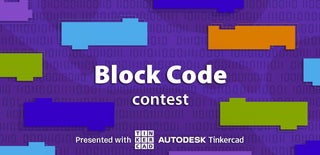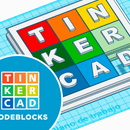Introduction: Re-discovering Nature With Tinkercad Codeblocks
Hi biomimicry enthusiasts! In this Instructable, I will show you how my students used Tinkercad Codeblocks software to extract patterns from nature and replicate them through block coding. This allowed them to create 3D digital models that they could then 3D print.
Through this example, you will see how block coding and 3D technology can be very useful tools for exploring and understanding the world around us in a deeper way. Let's rediscover nature using code!
Supplies
Software CAD / CAM
- Tinkercad Codeblocks
- Ultimaker Cura 3D (for 3D Printing)
Materials and tools:
- PLA 1.75 mm (3D printing filament)
- Scraper
- Cutting tweezers
Rapid prototyping machines:
- 3D Printer (We use a CR-10S from Creality)
Step 1: Biomimicry in Coding
Biomimicry is the practice of using nature as a model for design and engineering. In coding, this can involve using principles and patterns found in nature as inspiration for creating algorithms and software.
For example, the structure of a leaf's veins can be used as inspiration for creating an efficient network for distributing resources. By drawing from the wisdom and efficiency of natural systems, we can create more innovative and sustainable solutions for a variety of challenges. By embracing biomimicry in coding, we can tap into the vast knowledge and ingenuity of nature to create a better world for all.
Step 2: Mother Nature Probably Was the First Designer
Even though at first glance we may be dazzled by the complexity of nature's diverse shapes, the reality is that nature uses a few geometric strategies which, when mixed together, can achieve infinite combinations. Giving shape to everything we know. These strategies include:
- Symmetry
- Branching
- Fractals
- Growth and reaction diffusion
- Spirals
- Chaos
- Flow
- Meanders
- Bubbles
- Tessellation
- Packing and Cracking
- Spots and stripes
The golden rule of nature to create something was to "find the right shape to carry out a job in the most efficient way possible" (with the least loss of energy or resources). We can state that the shape of the elements we know, obey directly to a specific function. That is why we say that nature probably was the first designer even if it has been a process of trial and error over millions of years (evolution and adaptation).
However, trying to simulate behavior that triggers a specific shape using computer software can be very challenging for beginners, for this reason:
I encouraged my highschool students to analyze the geometric elements that make up the general shape of their inspirations and seek to replicate them using TinkerCad CodeBlocks (rather than trying to simulate a behavior).
Step 3: Seeing Through the Lens of a Biomimetic Designer
The work of a biomimicry designer involves observing and studying natural systems and organisms in order to understand how they function, and then using that knowledge to inform the design of new products, services, or technologies. This may involve studying how different animals move through their environment, how plants adapt to changing conditions, or how ecosystems function as a whole.
A Biomimicry designer apply this knowledge to various field such as Architecture, engineering, product design, fashion and textiles, transportation, renewable energy, and many more. they try to find inspirations in nature to design more sustainable solution.
One of the most common examples of biomimicry is the use of shark skin to design the surface of swimming pool, it was found that the skin of sharks is covered in tiny scales arranged in a pattern that reduces drag and increases speed, so now this pattern is applied in swimsuits and ship hulls to make them more efficient.
Seeing through the lens of a designer implies beginning to analyze everything we observe as a series of geometric objects related to each other through symmetry and patterns.
If you want to play with my block code to create starfish with multiple arms, you can access the model at: https://www.tinkercad.com/codeblocks/fuI9m46n8xx
Step 4: Symmetry
- WHY: Symmetry can be the result of various factors. Organisms that do not move, such as sea anemones, often have radial symmetry as it allows them to respond to potential threats and sources of food from any direction. On the other hand, animals that move in a particular direction tend to have a distinct top and bottom, as well as front and back, and are therefore bilaterally symmetric. This type of symmetry also allows for specialized body parts, such as the mouth and sense organs, to be located at the front, or head, of the animal.
- WHERE: Symmetry is pervasive in living and non-living things.
To learn the basics about symmetry and repetition (linear, grid, radial and random alignment) with tinkercad codeblocks, I recommend you to take a look at my previous instructable: Geology With TinkerCad CodeBlocks.
Step 5: Branching
- WHY: The collection and distribution of resources, such as nutrients or energy, is facilitated by processes such as diffusion and infusion. These processes allow for materials and heat to be transported efficiently throughout a large area, while minimizing the distance and stress involved. The use of multiple branches in certain structures helps to preserve information and allows for regrowth in the event of damage.
- WHERE: Trees, roots, leaves, antler, feathers, blood vessels, river systems.
Step 6: Fractals
- WHY: The purpose of fractals is to repeat the same pattern on smaller scales as that of the larger shape, this feature is called self-similarity, through a process known as iteration. This repetition of patterns at various scales generates complex and irregular shapes that hold a lot of detail that resemble the larger structure.
- WHERE: rocky coastlines, ferns, lichens, tree branches, roots, clouds, frost crystals, snowflakes, lightning, neuronal nets.
Step 7: Growth and Spirals
- WHY: Spirals are a unique feature that allows for expansion in size without altering the shape. They are able to uniformly occupy a space and maximize the quantity of material within it. Additionally, the ability to compress like a spring allows for an increase in length without any addition to width. These characteristics make spirals a versatile feature found in various natural and artificial structures where harmonic flow, compactness, efficient arrangement, increased transport, or anchoring are required.
- WHERE: spider web, mollusk shells, se shells, horns, composite florets, cacti, fem fronds, vine tendrils, pine cones, pineapple, eddies, hurricanes, convection currents, sunspots, planetary orbits, galaxies, DNA.
Step 8: Patterns of Flow
- WHY: The function of flow patterns in nature is to facilitate movement, circulation, transportation, and the expenditure of energy. These patterns, such as those found in fluids and gases, also have the ability to streamline the movement past fixed objects or barriers.
- WHERE: streams, rivers, glaciers, sand dunes, moray eel, snakes.
Step 9: Patterns of Perfection (Sphere, Hemisphere, Dome)
- WHY: Spheres are a balance between forces that expand and contract, and those that push outward and inward. They offer the least surface area for a given volume, which minimizes heat loss. The sphere shape provides an efficient use of materials and energy to enclose the maximum space.
- WHERE: soap bubbles, radiolarias, molecules, minimal surface, sponges, planets, stars, drops of water, eggs, seeds, cherries, pumpkins.
Step 10: Packing, Cracking, Nesting and Tessellations
- WHY: Sharing partitions in three-way joints allows to decrease the surface area needed to enclose a specific volume, this shape helps with space, material and energy saving, also provides the shortest path other than a line, and yields a strong structure.
- WHERE: soap bubbles, ice crystals, honey combs, corn kernels, turtle shells, snake skin scales, basalt columns, bird bones, network of veins in plants.
Step 11: Spots, Stripes
- WHY: There is an evolutionary rationale behind these patterns, as they serve functions that enhance the survival probability of the offspring of patterned animals. Two examples of such functions include camouflage and signaling. Camouflage allows animals to blend into their surroundings, making them less noticeable to predators, while signaling helps animals communicate with each other and attract mates or to indicate danger.
- WHERE: buttlerfly, zebra, angelfish, leopard, cuttlefish, ladybirds, tiger.
Step 12: Level Up!
Once you've learned the basics of replicating patterns found in nature with code, you can take your design skills to the next level by migrating to procedural or parametric modeling software. These programs combine block programming with surface / mesh design, allowing you to not only replicate the shape of an object but also simulate its behavior (this can include the way the object interacts with light, air flow, fluid dynamics, and more).
With this advanced software, you can explore the real-world implications of your designs and create objects that not only look beautiful but also function in a desired way. It is a good way to experiment and put in practice all that you've learned.
Step 13: Keep Growing
If you're interested in learning more, you can visit the first posts on my Instagram where I've shared more advanced tutorials using Rhinoceros and Grasshopper plug-in software. These tutorials delve deeper into the application of these principles using cutting-edge tools and techniques.
I hope to see you there, and thank you for reading!
Step 14: References
Ball, P. (2016). Patterns in Nature: Why the Natural World Looks the Way It Does (Illustrated). University of Chicago Press.
Stevens, P. S. (1974). Patterns in Nature (1st ed.). Little Brown & Co.

Judges Prize in the
Block Code Contest














4 Comments
5 weeks ago
Definitely going to try it out! I've been looking into grasshopper for a while, but it seemed so intimidating. This on the other hand seems very down to earth. Thank you for writing this great instructable!
Reply 4 weeks ago
With pleasure!
Grasshopper can be intimidating at first, but once you understand the basics of block coding everything becomes logical; it's just a matter of understanding the UI. Either way, I would recommend mastering Rhinoceros first before going into the plug-in.
3 months ago
You're some Tinkercad wizard
Reply 3 months ago
Thank you! lol but actually the wizards are my students, the magic behind TinkerCad is that it is so simple to use that it presents unlimited possibilities (the limit is your imagination, like "playing with legos" you can make very simple or really complex models).